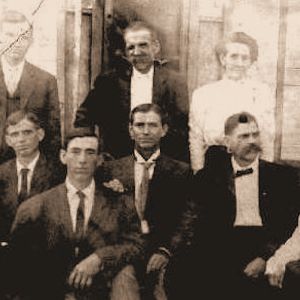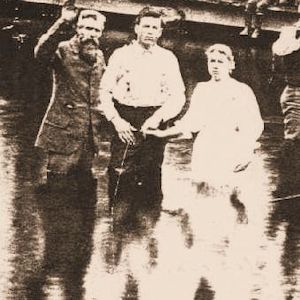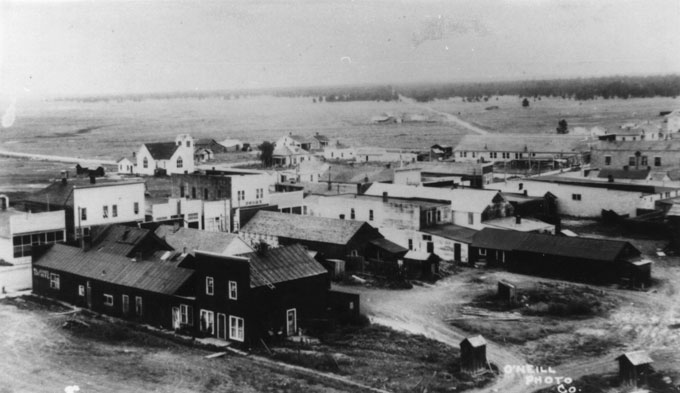




I am Rebecca Maloney, Webmistress and Temporary Coordinator for this Weston County, Wyoming site. I hope you enjoy your visit. Please email me if you have any suggestions or contributions you would like to make.

The coal-mning town of Cambria, 1908.
Weston County was named for John Weston, who discovered coal there
in 1887. Wyoming Tales and Trails The coal-mning town of Cambria,
1908. Weston County was named for John Weston, who discovered coal
there in 1887. Wyoming Tales and Trails The sea receded many
millions of years ago, however, and the land is now categorized as a
Plains Grassland ecosystem, or Great Plains. Weston County is
divided into four dominant land categories. The Pierre Shale Plains
and Badlands, characterized by clay soil and gently rolling divides
and hills around creeks and river valleys, make up about a quarter
of the county. The Black Hills and Black Hills foothills, with
steep-sided ridges, rocky hills and plateaus make up another
quarter. The remaining half of the county is known as the Northern
Rolling High Plains, flat lands with sandy soils. Elevations range
from 3,600-6,500 feet. Wind is fairly constant at an average 8 mph,
with gusts up to 75 mph. The county receives just 10-19 inches of
precipitation each year and has a 120-day growing season between
freezes in mid-May and mid-September. The county’s 1.5 million acres
have various uses, with by far the largest amount—more than 1.2
million —used as range. Other uses include forest, pasture and
crops. Ownership is predominantly private, with some industry,
county, state and Bureau of Land Management and U.S. Forest Service
land. Early history Weston County is located in the northeast corner
of Wyoming, just south of Crook County and with its eastern border
the South Dakota state line. The earliest inhabitants of the area
were American Indians: the Black Hills feature prominently in
folklore and stories of the Kiowa, Crow, Cheyenne and Lakota tribes,
the last of whom were pushing the Crow further west by the early
1800s. The first whites in the area may have been Louis and Francois
de la Verendrye, Canadian French fur traders who in 1742 and 1743
explored west from the Big Bend of the Missouri River at least as
far as the Black Hills. The land came under nominal United States
control in 1803, when representatives of President Thomas Jefferson
negotiated purchase of the Louisiana Territory from France. Indians
still controlled it, however, and continued to do so for
three-fourths of a century. In June 1834, Congress designated all
non-state or non-territory land west and east of the Mississippi
River as Indian Country. What’s now Weston County officially became
part of the new Nebraska Territory in May 1854. Later it was part of
Dakota Territory, then, briefly Idaho Territory, then Dakota
Territory again and finally, on July 25, 1868, was included as part
of the brand-new Territory of Wyoming. Even then, however, any white
people who passed through what’s now northeastern Wyoming kept on
going. Early industry Indians knew of gold in the area but, hoping
to preserve their land and lifeways, kept the location of this
treasure a secret. Their efforts worked for some time. Westbound
settlers and miners flooded the Oregon/California/Mormon Trail
across what’s now central Wyoming in the 1840s, 1850s and 1860s, but
other than soldiers, few white people came to the new Wyoming
Territory to stay until after the completion of the Union Pacific
Railroad in 1869. Northeastern Wyoming remained in tribal hands the
longest of any part of the territory. Cheyenne and Lakota Indians
fought wars in the 1860s to keep it that way. In 1874, Colonel
George Custer led a 1,000-man expedition into the Black Hills,
discovered gold, and soon, miners and settlers were pressuring the
government to persuade the tribes to cede their lands. The military
campaigns of 1876, which ended in Custer’s defeat and death, finally
drove all the tribes out of northeastern Wyoming Territory and onto
reservations in what are now Montana, the Dakotas and Oklahoma the
following year. Beginning in 1877, herds of cattle were trailed to
Wyoming from Texas, and cattle raising soon became a central part of
the economy of Crook County, half of which later became Weston
County. Many businessmen from the East and from Britain purchased
cattle and hired cowboys to care for their stock as the industry
grew. A devastating winter in 1886-1887 decimated the herds, and
many investors went broke. But some cowboys and their wealthy
backers were determined, and some large herds remained. The cattle
industry could be lucrative but was notoriously expensive to break
into. New homesteaders in the area began bringing in sheep, which
required a lower initial investment than cattle. These people in the
late 1880s created Irontown, which is now Upton, Wyo. Historians
believe the town began as a place where cowboys, ranchers,
homesteaders and especially sheep men could obtain supplies.
Newcastle, Wyo., was founded around the same time by the Chicago,
Burlington and Quincy Railroad, then building across Wyoming’s
northeast corner from Nebraska to Montana on a route planned to take
advantage of ready coal supplies to fuel its locomotives. This
bird’s-eye view of early Upton shows houses and buildings that
sprang up around the Burlington tracks. Alice Schuette Collection,
Weston County Historical Society. This bird’s-eye view of early
Upton shows houses and buildings that sprang up around the
Burlington tracks. Alice Schuette Collection, Weston County
Historical Society. In 1887, John Weston and
Frank W. Mondell found coal deposits in
what would soon become Cambria, a coal settlement. By 1890, the mine
employed 750 people, and the camp’s population was 1,500, with 23
nationalities represented. Newcastle, meanwhile, was founded in 1889
and the Burlington tracks arrived soon afterward. Weston County was
eventually named for John Weston. Mondell, a businessman with many
interests, was Newcastle’s first mayor. He was elected to the state
Legislature in 1893, and to the U.S. House of Representatives s in
1894, where he served one term. He was elected again in 1898, and
after serving 12 terms, ran for the Senate in 1922—but lost to the
popular Democratic incumbent, John B. Kendrick. County formation The
final Wyoming Territorial Legislative Assembly created Weston County
on March 12, 1890, and named it for John Weston to honor his
discovery of the coal deposits. Crook County was split in half, and
the southern half was designated Weston County. Soon after,
Territorial Governor Francis E. Warren appointed George H. Purmort,
Harry C. Hensel and Ralph A. Weston to the board of organizing
commissioners for the county. In early April, voters selected
Newcastle as county seat. Officers such as commissioners, county
clerk, attorney, treasurer, sheriff, school superintendent, justices
of the peace and constables were elected May 14, 1890. Early
economic troubles After being split from Crook County, Weston County
remained liable for part of Crook County’s debt under the
territorial law. Weston County’s portion was $14,500, and despite
levying the maximum allowable tax, debt problems stuck doggedly to
the new county for several years.
In October 1890, the county issued bonds in the amount of $20,000.
Residents were uninterested in buying them, however, and the debt
continued to climb. The county again issued $20,000 in bonds in
February 1891, and on April 8 the bonds were bought by the Bank of
Newcastle. Finances were still tight the following November,
however, and the cash-strapped county commissioners voted, as a
stopgap measure, to cut the jobs of deputy county officers—deputy
sheriff, deputy county clerk, etc.—that they had added to the county
payroll just the year before. Things went from bad to worse when the
nation was swept by the Panic of 1893, starting a depression that
lingered most of the decade. Tax revenues declined, and the county
was still unable to pay its bills. Three banks sued Weston County in
September 1893 for nonpayment of more than $10,000 in county
warrants. To compensate, commissioners issued more bonds, nearly
doubling the debt to a total of nearly $40,000. In April 1896, the
Grand Island and Northern Wyoming Railroad, a Burlington subsidiary,
refused to pay taxes to Weston and Crook counties, citing debts both
counties owed the company. Weston and Crook county cooperated to
file a lawsuit to collect the taxes, and the counties ultimately
received their tax money. Still, hard times persisted and the county
was sued again in March 1897 for failure to pay for a variety of
contracts and services rendered. Although officials fully
acknowledged the debt, county coffers lacked enough funds to pay
what was owed. Finally, in 1899, the economy began to improve, and
county finances with it. On Feb. 16, 1901, Weston County
commissioners approved the purchase of real estate in Newcastle for
expanded county offices, a sign they had money to spare at last. Oil
industry The first oil wells in Weston County were drilled between
1890 and 1901. The largest oil companies, Mike Henry Oil Company,
Illuminator Oil Company and M.J.
Coyle, contributed to this boom. Demand for crude oil during World
War I helped make the industry profitable throughout the United
States. The oil business has dominated Weston County's economy since
the 1920s. The Sioux Refinery in Newcastle, 1953. Wyoming Tales and
Trails. The oil business has dominated Weston County's economy since
the 1920s. The Sioux Refinery in Newcastle, 1953. Wyoming Tales and
Trails. In March 1920, the discovery of a gusher near Osage, Wyo.,
halfway between Newcastle and Upton, heralded the beginning of a new
and continuing era of prosperity for Weston County. The oil well
produced between 1,500 and 2,500 barrels of oil per day. People from
throughout the nation, lured by the promise of work and wealth,
began arriving in Weston County—mostly workers and a few families. A
second significant well was discovered in July of the same year, and
more companies from around the country set up drilling rigs.
Refineries were built in Osage, Newcastle, Four Corners, Red Butte,
Thornton and other small towns. Land prices skyrocketed to $1,000
per acre in Weston County, and with the throng of workers came
increased violence, petty crimes, oil disputes and con artists. As
demand for oil increased, interest in bentonite grew. Weston County
is rich in bentonite, a fine clay used primarily in oil drilling to
flush cuttings out of the hole as the well is being drilled, though
it has many other uses as well. Several bentonite-refining plants
were constructed, with the first at Clay Spur near Osage and later
plants in Newcastle. After World War I, falling demand for oil
slowed the industry, and the boomtown of Osage went bust. Also after
the war, steeply falling agriculture prices hit farmers and ranchers
hard, and their difficulty paying their debts in turn was hard on
the small-town banks that lent them money. Industrial workers left
the county, looking for the next opportunity, and Weston County
towns became quiet, sleepy family areas with little sustainable
industry. By the mid-1920s, Weston County, like much of the rest of
Wyoming, was in a depression well before the stock market crash of
1929, which signaled the start of the Great Depression nationwide.
Weston County's first bentonite plant at Clay Spur, near Osage,
opened in the 1920s and was abandoned by the time this photo was
taken in 1989. The industry is still important in the area. Wyoming
Tales and Trails Weston County's first bentonite plant at Clay Spur,
near Osage, opened in the 1920s and was abandoned by the time this
photo was taken in 1989. The industry is still important in the
area. Wyoming Tales and Trails Bentonite was the first industry in
Weston County to start coming out of the slump. Demand had increased
as more and more uses –cement and plaster, cosmetics, insecticides,
herbicides and textiles—were found for the product. In October 1935,
the bentonite refineries in Weston County began working 24-hour
shifts to fill all the new orders. By the end of 1939, Weston County
bentonite was being shipped all over the United States and to Canada
and South America. By that time, war had begun again in Europe. As
another global conflict approached, demand for oil and bentonite
increased, and agricultural prices rose. So-called “World War II
industries” in the county included beef cattle, dairy cattle, brood
sows and egg production. Workers from Arizona and New Mexico—people
of Indian and Mexican heritage—came to Weston County to work as
sheepherders, lambing hands, sugar-beet harvesters and general farm
workers. There had been small sawmills before in Weston County, but
the Berman Sawmill, opened by local businessman Dan Berman in 1950,
was the first to operate on an industrial scale. It created 20 jobs,
and soon was producing 250,000 board feet of lumber per month,
primarily from timber cut in the Black Hills. The sawmill finally
closed in 2000. Additional oil wells were discovered during the war
years and immediately afterward, and another boom-bust
cycle began. This oil boom peaked in the
mid-1950s. Workers again rushed to the county, and the population
jumped from a pre-war total of 4,958 in 1940 to 7,929 in 1960. The
industry slowed by the late 1950s, but the continuing operations of
the sawmill softened the economic impact of the decline of oil.
Weston County today Of Wyoming’s 23 counties, Weston County ranks
18th in size at about 2,400 square miles, and 20th in population as
of the 2010 census count of 7,208. It includes two towns, Upton and
the county seat of Newcastle as well as the unincorporated
communities of Hill View Heights, Osage and Four Corners. The
boom-bust cycle continued throughout several decades, with a boom in
the 1960s bolstered by the national oil embargo in the 1970s. When
prices began to fall in 1980, another bust set in. As of early 2012,
prices again are high, and while most oil drilling now takes place
outside the county’s borders, the industry is still an active part
of the area’s economy. Newcastle’s oil refinery, long owned by the
Wyoming Refinery Company, was bought by Black Elk LLC, of Houston,
in 2011, with plans to upgrade pollution protections and increase
output. On Aug. 24, 1969, the Burlington Railroad suspended
passenger train service in Weston County. The railroad continues as
a major employer because of coal transport from two mines, Arch Coal
Company’s Black Thunder Mine and Rio Tinto Energy America’s Jacobs
Ranch Mine, outside the county near Wright, Wyo. Many residents own
cattle and sheep ranches. Weston County Health Services in Newcastle
provides employment for medical and social workers and others. The
Northern Wyoming Mental Health Association, also in Newcastle, was
established in April 1961 to provide care for community members,
specifically war veterans, and the 41-bed Weston County Manor opened
in 1969 to assist elderly members of Weston County. Both facilities
continue to serve the community today. The Wyoming Department of
Corrections operates the Wyoming Honor Conservation Camp & Wyoming
Boot Camp, which is located just north of Newcastle and provides
work experience for prisoners who have met good behavior standards.
Make sure you check the "Research Resources" section!

|
|||
| search engine by freefind |
|
|
||
WESTON COUNTY |
||
| NIOBRARA COUNTY |
|
If you have questions, contributions, or problems with this site, email:
Coordinator - Available for Adoption
State Coordinator: Colleen Pustola
Asst. State Coordinators: Rebecca Maloney
If you have questions or problems with this site, email the County Coordinator. Please to not ask for specfic research on your family. I am unable to do your personal research.